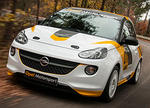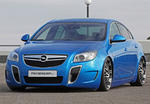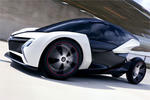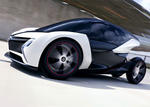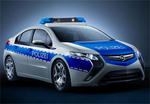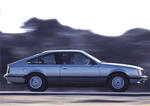
The Opel RAK 2, Fritz von Opel's rocket car, set a speed record in 1928 at Berlin's AVUS race track. On May 23 it will be Fritz von Opel's record 80th Anniversary. The Opel RAK 2 managed that day 80 years ago a top speed of 238 km/h with the help of 24 solid-fuel rockets packed with 120 kilograms of explosives. Fritz von Opel chose the high-speed AVUS track in Berlin because the company's racetrack was not engineered for speeds over 140 km/h.
Opel Press Release:
Before the eyes of 3000 invited guests, the rocket age began May 23, 1928 at Berlin’s AVUS race track.
That was the day, with a long plume of fire and smoke burning behind his shiny black cigar-shaped race car outfitted with two massive wings to keep the machine grounded, Fritz von Opel set a speed record for rocket-propelled cars, hitting an estimated 238 km/h in his RAK 2.
Von Opel, grandson of Opel Motor Car Company founder Adam Opel, and his partners Friedrich Sander and Max Valier used 24 solid-fuel rockets packed with 120 kilograms of explosives to propel the RAK 2 forward. Each time von Opel pressed on the gas pedal he ignited two rockets increasing power


until he reached full strength and his world record.
“I stopped thinking. I was acting on instinct alone, with uncontrollable forces raging behind me,” von Opel gushed when he stepped from the car.
The adrenalin still flowing, von Opel immediately announced his ultimate goal: He wanted to fly in a rocket-powered airplane. “Dream with us of the day in which the first space ship can fly around our earth faster than the sun,” von Opel urged the crowd.
A bit more than a year later, September 30, 1929, von Opel had a small taste of that dream when he became the first man to fly in a rocket-propelled plane.
“The Advance into Space”
The dream started when Max Valier, a South Tyrolean astronomer, test pilot and author of “The Advance into Space” approached von Opel in 1927 seeking support for Valier’s rocket engine
research. Von Opel, himself a race car driver and pilot, recognized the potential of rocket technology as well as its advertising value for his family’s company. From then on, Opel’s factory in the German town of Rüsselsheim began researching innovative modes of propulsion, measuring the thrust of various rocket types on a specially-constructed test bench. Engineer and rocket-maker Sander, based near Bremerhaven, delivered state-of-the-art solid-fuel rockets to them. Sander already had made his reputation manufacturing rockets for maritime rescue operations; his missiles were used to propel ropes to ships in distress.
By the spring of 1928, the company announced the public debut of a rocket-powered car,
called RAK 1. The event took place April 11 on the company’s own track in Rüsselsheim, the first permanent race and test track in Germany. In just eight seconds, the RAK 1 reached a speed of 100 km/h, before coasting to a stop. The test drive was hailed as a new technological triumph; newspaper reports were full of enthusiasm for the future. Fantasies of reliable flights to America and the development of spacecraft began to look like a possibility.
“Sitting on 120 kilos of explosives – enough to blow up a whole neighborhood”
Because the Opel company racetrack was not engineered for speeds over 140 km/h, Fritz von Opel selected the high-speed AVUS track in Berlin for his record-setting test drive of a technologically and aerodynamically-redesigned RAK 2.
The AVUS track provided a high-profile venue to present Opel’s innovative propulsion system to the public. The 3000 guests from show business, sports, science and politics gathered on the northern grandstand in anticipation of the test. Movie star Lilian Harvey and boxing idol Max Schmeling were among the celebrities in the audience.
The rocket vehicle was still concealed from view by a canvas tarpaulin, when Johann Schütte, President of the Scientific Society for Flight, addressed the audience, honoring the work of Valier.
The RAK 2 was unveiled and rolled to the starting line, where the rockets were installed and connected to the ignition cables. The audience looked at the rocket car in awe: A slender, black body mounted on a chassis borrowed from the Opel 10/40 PS. It was fitted with two oversized wings to compensate for the calculated lift and prevent unintentional flight. With the power of 24 rockets, ignited by a specially developed, pedal-activated electrical system and generating 6000 kilograms in thrust, the RAK 2 was designed to reach a speed beyond the 200 km/h mark, but no one knew exactly how fast it could go.
The 29-year-old von Opel, wearing an aviator’s jacket and goggles, sat behind the steering with “unsettling thoughts shooting through” him, as he later recalled, “sitting on 120 kilos of explosives – enough to blow up a whole neighborhood.”
“Uncontrollable forces raging behind me”
Finally, only the legendary Opel race car driver Carl Jörns, Valier and the rocket-maker Sander remained at the pilot’s side. Von Opel remarked later: “Sander shakes my hand. Why so formal?”
It soon became clear to him.
“I step on the ignition pedal and the rockets roar behind me, throwing me forward. It’s liberating. I step on the pedal again, then again and – it grips me like a rage – a fourth time. To my sides, everything disappears. All I see now is the track stretched out before me like a big ribbon. I step down four more times, quickly – now I’m traveling on eight rockets. The acceleration gives me a rush. I stop thinking. I’m acting on instinct alone, with uncontrollable forces raging behind me.”
The tremendous speed caused the front end of the rocket car to leave the ground toward the end of the test: The wings were not angled for sufficient negative lift. Only the quick reactions of the seasoned pilot kept the RAK 2 on course, averting a catastrophe.
In less than three minutes, the spectacle was over. Von Opel and his rocket car became an overnight sensation as the news shot around the world: The top speed during the record-setting test run is 238 km/h.
Silver-screen darling Lilian Harvey confided to a reporter: “I’d like to ride in the rocket car with Fritz von Opel.” The magazine “Das Motorrad” (The Motorcycle) wrote: “No one could escape the impression that we had entered a new era. The Opel car with a rocket engine could be the first practical step toward the conquest of space.” American silent film star Jackie Coogan later was photographed sitting in a prototype of a RAK.
“Rocket Fritz” had become a hero, yet there were new challenges ahead. A month later, in June, 1928 the team set a new world record for speed on rails in an unmanned test of RAK 3 on a specially closed stretch of track near Celle-Burgwedel.
A few weeks later, in attempt to break that record, the RAK 4 was destroyed in a massive explosion. This was followed by further tests with a rocket-powered motorcycle, but these were stopped by the authorities as too dangerous.
Key to success was finding a plane that could withstand the powerful thrust
The team was under time pressure. Other men across the world had the same dream of space flight. American Robert Goddard had successfully launched a liquid-fueled rocket in his Aunt Effie’s farm in Massachusetts in 1926, two years earlier.
Von Opel and Sander had a problem finding a plane sturdy and safe enough to withstand a rocket launch. They unsuccessfully tried to build their own and were disappointed by a few other models made nearby. Eventually they partnered with a man named Julius Hatry.
“From 1927 to 1929, I had been working on models for rocket-fuelled airplanes. I had flown models successfully and had decided to build a manned craft,” Julius Hatry said in an interview in 2000. Initially he turned down von Opel’s offer to team up. When he discovered that the car magnate was then in negotiations to purchase one of his airplanes for modification, Hatry relented.
On Sept. 10, 1929 in a hunting field just outside Rüsselsheim, von Opel, Hatry and Sander made their first tests, with only a handful of selected onlookers, including a photographer from The New York Times. The aviators packed one of Hatry’s specially-built planes with 100 cylinder rockets in the rear; each cylinder packed with 90 kilograms of explosives.
It was a massive failure. The plane remained on the ground and burned up. The problem, they felt, was in the initial launching.
On a second attempt that day, the group used a standard rubber-band launcher. Once in the air – only perhaps a meter or two off the ground -- von Opel launched his rockets and flew 1,400 meters.
The New York Times published the photo in its October 6 Sunday edition. But to true aviators at the time, without the crucial unassisted rocket launch, they had not yet succeeded in flying a “jet.”
After a few adjustments, they secretly tried again on Sept. 17, 1929 with Hatry in the cockpit. It worked. Hatry flew roughly 500 meters about 25 meters above ground with the help of two catapult rockets that together created 700 kilograms of thrust. It was enough for von Opel, the media hound, to organize another publicity event.
On Sept. 30, 1929, at Frankfurt’s Rebstock airport in front of a large crowd, with French filmmakers at the ready, the team packed 16 rockets into the tail of Hatry’s plane. Manually, they lit the catapult rockets one by one, but the rockets ignited too late to provide the lift von Opel needed to get off the ground. The launch rockets failed to ignite correctly a second time as well.
Sander had not reckoned on a third attempt. He had only 11 rockets left, each with a burning time of about 24 seconds and 24 kilograms of thrust. He was wary of trying a third time, but von Opel insisted.
With Sander and Hatry finally in agreement, von Opel climbed aboard again. That time the start worked, the plane launched only on rocket-power flew at an estimated 150 kilometers per hour about 25 meters above ground for 80 seconds.
The Rocket Age had begun.
“He Hopes to See Business Men Crossing Atlantic in Rocket Airplane.”
Six rockets failed to ignite and he fuel ran out quickly, forcing von Opel to make an emergency landing. No one was injured, the plane was destroyed, but it didn’t matter to von Opel and his team.
“My first rocket flight! You want to hear something about my impressions and emotions ten minutes after my fight, when I myself can scarcely grasp my joy,” he wrote in an article for The New York Times, cabled to the U.S.
“It is magical, flying like that, powered by nothing more than the combustion gases streaming out of the engines at 800 kilometers an hour. When will we be able to harness the full power of these gases? When will we be able to fly around the world in five hours? I know this time will come and I have a vision of future world travel which will bring together all the people of the earth to live as one.
So I race towards this vision like a dream with no sense of space and time. A machine flying almost by itself. I hardly need to touch the controls. I feel only the borderless intoxicating joy of this first flight.”
Immediately, the trio made plans for their next plane, their next flight.
One month later, however, stock markets around the world crashed, sending Germany – and the world – into a tailspin.
Von Opel’s dream, though, was not over. A New York Times article dated December 24, 1929, states that the head of the Opel Motor Car Company told reporters on arriving in the U.S. “He Hopes to See Business Men Crossing Atlantic in Rocket Airplane.”




